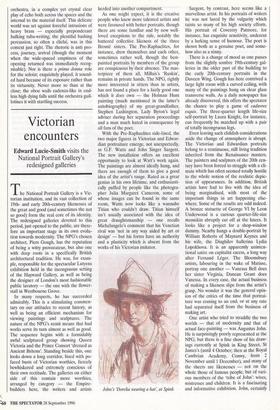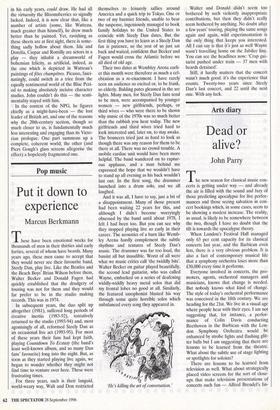Victorian encounters
Edward Lucie-Smith visits the National Portrait Gallery's redesigned galleries The National Portrait Gallery is a Vic- torian institution, and its vast collection of 19th- and early 20th-century likenesses of the great and good (and sometimes the not so good) form the real core of its identity. The redesigned galleries devoted to this period, just opened to the public, are there- fore an important stage in its own evolu- tion towards modernity. The NPG's chosen architect, Piers Gough, has the reputation of being a witty provocateur, but also one with deep roots in a specifically British architectural tradition. He was, for exam- ple, responsible for the spectacular Lutyens exhibition held in the incongruous setting of the Hayward Gallery, as well as being the designer of London's most fashionable public lavatory — the one with the flower- stall in Westbourne Grove.
In many respects, he has succeeded admirably. This is a stimulating commen- tary on our attitudes to recent history, as well as being an efficient mechanism for viewing paintings and sculptures. The nature of the NPG's remit means that bad works serve its turn almost as well as good. The sequence begins with a formidably awful sculptured group showing Queen Victoria and the Prince Consort 'dressed as Ancient Britons'. Standing beside this, one looks down a long corridor, lined with po- faced busts of Victorian worthies, fiercely bewhiskered and extremely conscious of their own rectitude. The galleries on either side of this contain more worthies, arranged by category — the Empire- builders here, the writers and artists herded into another compartment.
As one might expect, it is the creative people who knew more talented artists and were favoured with better portraits, though there are some familiar and by now well- loved exceptions to the rule, notably the battered collective likeness of the three Bronte sisters. The Pre-Raphaelites, for instance, drew themselves and each other, sometimes rather well, though the best- painted portraits by members of the group are conspicuous by their absence. The mas- terpiece of them all, Millais's 'Ruskin', remains in private hands. The NPG, rightly more interested in sitters than in artists, has not found a place for a fairly good one which it does own — the Holman Hunt painting (much mentioned in the latter's autobiography) of my great-grandfather, Stephen Lushington, Lady Byron's legal adviser during her separation proceedings and a man much hated in consequence by all fans of the poet.
With the Pre-Raphaelites side-lined, the two major figures in Victorian and Edwar- dian portraiture emerge, not unexpectedly, as G.F. Watts and John Singer Sargent. The new installation offers an excellent opportunity to look at Watt's work again. The paintings are almost ideally hung, and there are enough of them to give a good idea of the artist's range. Rated as a great genius in his own lifetime, and enthusiasti- cally puffed by people like the photogra- pher Julia Margaret Cameron, some of whose images can be found in the same room, Watts now looks like a wannabe Titian who couldn't draw. Titian himself isn't usually associated with the idea of great draughtsmanship — one recalls Michelangelo's comment that his Venetian rival was 'not in any way aided by art or design' — but his forms have an authority and a plasticity which is absent from the works of his Victorian imitator.
John's 'Dorelia wearing a hat' at Spink Sargent, by contrast, here seems like a marvellous artist. In his portraits of writers he was not lured by the vulgarity which taints so many of his high society efforts. His portrait of Coventry Patmore, for instance, has exquisite sensitivity, undercut by a lurking sense of humour. The poet is shown both as a genuine poet, and some- how also as a ninny.
There is a change of mood as one passes from the slightly sombre 19th-century gal- leries in the older part of the building to the early 20th-century portraits in the Duveen Wing. Gough has here contrived a large light room with a curved ceiling, with many of the paintings hung on clear glass transverse walls. As a daily newspaper has already discovered, this offers the spectator the chance to play a game of cadavres exquis. The three-quarter length life-size self-portrait by Laura Knight, for instance, can frequently be matched up with a pair of totally incongruous legs.
Even leaving such childish considerations aside the change of atmosphere is abrupt. The Victorian and Edwardian portraits belong to a continuous, still living tradition inherited from the Renaissance masters. The painters and sculptors of the 20th cen- tury have been forced to struggle with a cli- mate which has often seemed totally hostile to the whole notion of the realistic depic- tion of appearances. In addition, British artists have had to live with the idea of being marginalised, with most of the important things in art happening else- where. Some of the results are odd indeed. A bronze statuette of George VI by Leon Underwood is a curious quarter-life-size mannikin abruptly cut off at the knees. It looks like a project for a shop-window dummy. Nearby hangs a double-portrait by William Roberts of Maynard Keynes and his wife, the Diaghilev ballerina Lydia Lopokhova. It is an apparently uninten- tional satire on capitalist excess, a long way after Fernand Leger. The Bloomsbury artists, labouring in the wake of Matisse, portray one another — Vanessa Bell does her sister Virginia, Duncan Grant does Vanessa. In every case, the actual business of making a likeness slips from the artist's grasp. No wonder it was the general opin- ion of the critics of the time that portrai- ture was coming to an end, or at any rate had separated itself from the business of making art.
One artist who tried to straddle the two worlds — that of modernity and that of actual face-painting — was Augustus John. He is surprisingly poorly represented at the NPG, but there is a fine show of his draw- ings currently at Spink in King Street, St James's (until 4 October; then at the Royal Cambrian Academy, Conwy, from 2 November until 1 December), and many of the sheets are likenesses — not on the whole those of famous people, but of vari- ous members of the 'tribe of John': wives, mistresses and children. It is a fascinating and informative exhibition. John, certainly in his early years, could draw. He had all the virtuosity the Bloomsberries so signally lacked. Indeed, it is now clear that, like a number of artists (some, like Watteau, much greater than himself), he drew much better than he painted. Yet, ravishing as these sheets are at first sight, there is some- thing sadly hollow about them. Ida and Dorelia, Caspar and Romilly are actors in a play — they inhabit a dreamworld of bohemian felicity, as artificial, indeed, as the one which is depicted in Watteau's paintings of fetes champetres. Picasso, fasci- natingly, could switch in a trice from the equally sentimental world of the Blue Peri- od to making absolutely incisive character studies. John couldn't do this — the senti- mentality stayed with him.
In the context of the NPG, he figures chiefly as a might-have-been — the lost leader of British art, and one of the reasons why the 20th-century section, though so much closer to us, is fundamentally much less interesting and engaging than its Victo- rian prologue. One part summons up a complete, coherent world; the other (and Piers Gough's glass screens allegorise the effect) a hopelessly fragmented one.



















































































 Previous page
Previous page